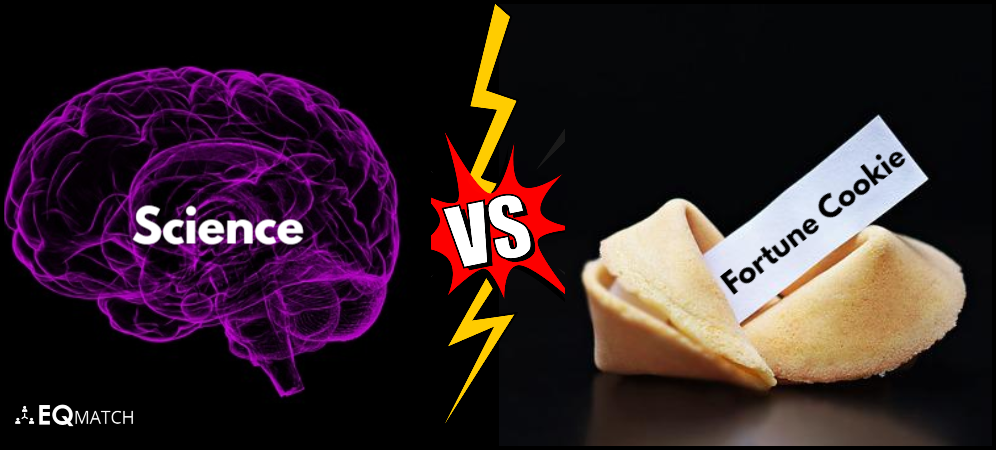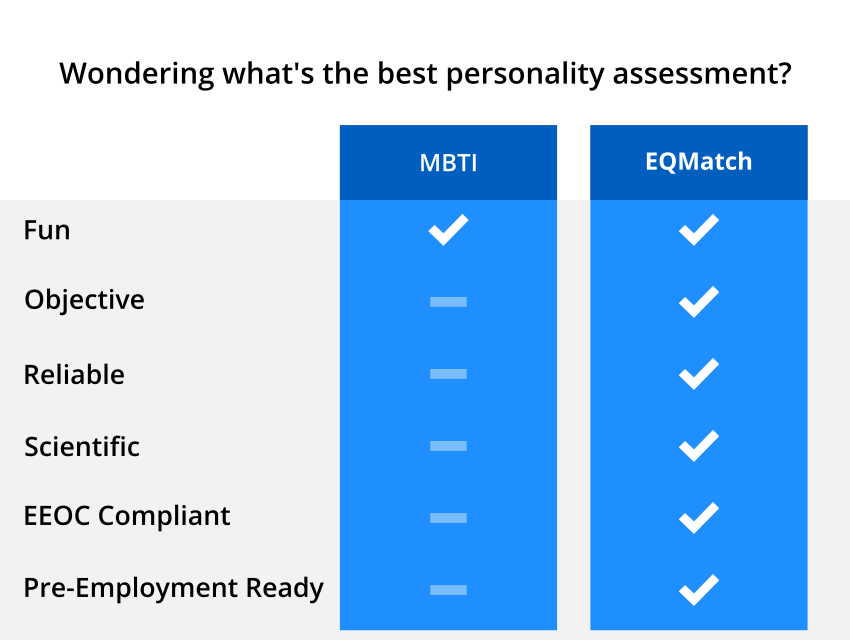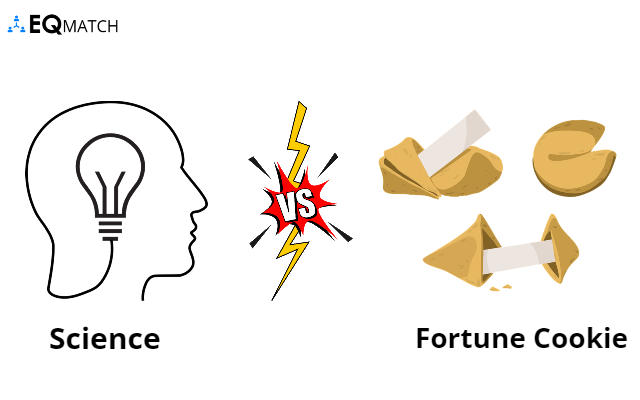Did you know that MBTI originally focused on the WWII job market?
Generally referred to as the Myers Briggs personality test, MBTI actually stands for Myers Briggs type indicator.
For decades, the Myers Briggs Type Indicator (MBTI) has been used by businesses, institutions, and individuals as a way to peer into the human psyche, offering a simple way to categorize individuals into 16 different Myers Briggs Personality Traits or Types.
The promise of the Myers Briggs Personality Test is that it would be able to predict how the individual will behave in a business setting or a relationship.
Many HR professionals believe that this could help build more diverse teams, thus leading to higher job productivity and reduced turnover intent.
Sadly, this is far from the truth.
Myers Briggs Personality Test: History and origins
The original version of the Myers Briggs Personality Test was developed by Katharine Cook Briggs and her daughter Isabel Briggs Myers.
Katharine started her research into personality in 1919, based on personality differences between Isabel’s husband, and other family members.
She developed a personality typology based on four temperaments: meditative/thoughtful, spontaneous, executive, and social.
While Isabel (Myers) received a degree from Swarthmore College in 1919, she (as well as her mother) did not have any formal education in psychology.
They both were self-taught in psychometric testing, learning rudimentary assessment construction, scoring, validation, and statistical methods.
In 1923, Katharine Briggs discovered that her observations had a close resemblance to the work of Carl Jung, published in the book “Psychological Types” (originally published in Germany in 1921).
During World War II, the mother-daughter duo developed indicators with the goal that personality preferences would help women enter the industrial workforce for the first time.
In 1944 they published The Briggs Myers Type Indicator Handbook, which was later renamed “Myers-Briggs Type Indicator”.
Myers later joined hands with a consultant named Edward N. Hay to package MBTI for hiring.
Hay had some big clines such as General Electric, Standard Oil, Bell Telephone, and the US Army. Soon, the test gained popularity as a tool to hire (and fire) employees.
Understanding the Myers Briggs personalities test types
Myers Briggs 16 personalities fall under ISTJ, ISFJ, INFJ, INTJ, ISTP, ISFP, INFP, INTP, ESTP, ESFP, ENFP, ENTP, ESTJ, ESFJ, ENFJ, and ENTJ.
The Myers Briggs personality traits have four different scales- Extraversion (E) – Introversion (I), Sensing (S) – Intuition (N), Thinking (T) – Feeling (F), and Judging (J) – Perceiving (P).
Why use the Myers Briggs personality test?
According to the Myers-Briggs Company, the assessment was designed “to help people understand personality differences in the general population”.
The test is a fun way to be an icebreaker exercise for a team or a class.
However, use caution, when using MBTI assessments at the workplace, as it places static labels on people.
Myers Briggs Personality Test: Accuracy and Validity
Subjective assessments, like MBTI, rely solely on self-reported “feeling”, rather than objective “factual” scoring.
The bias in subjective assessments could vary based on the subject’s understanding of the question and the answer scale.
Additionally, when test results are subject to judging, respondents tend to provide answers that are closer to what is expected, rather than the true perception.
The Myers-Briggs Type Indicator assumes that most people have a preference for specific psychological types, e.g. extroverted vs. introverted.
However, most studies see patterns similar to normal distribution or the “Bell Curve”, indicating that the majority of people are actually in the middle of the scale.
Statistical validity and test validity of the MBTI have been widely criticized.
Close to 50% of the published material on MBTI was produced for training conferences of the “Center for the Application of Psychological Type”, and papers for the “Journal of Psychological Type”.
It is interesting to note that both were edited and paid by funds from MBTI sales, and lack critical scrutiny.1
Many studies that support MBTI are unscientific or have a weak methodology. 2
The Smithsonian Magazine wrote off the MBTI assessment, calling it “pretty much meaningless.”
The Scientific American called the Myers-Briggs Type Indicator “one of the worst personality tests in existence.”
And as per Psychology Today, the MBTI is “the fad that won’t die.”
Psychometric specialist Robert Hogan had a unique angle at the MBTI. He said, “Most personality psychologists regard the MBTI as little more than an elaborate Chinese fortune cookie…”3

Using MBTI for Hiring Assessments
Even with prolific use of Myers-Briggs Type Indicator by many Fortune 500 companies, HR leaders and teams should never use MBTI for hiring.
The Myer & Briggs Foundation even states: “It is not ethical to use the MBTI instrument for hiring or for deciding job assignments.”.
It is not just unethical, it is illegal as well.
According to the Civil Rights Act of 1964, Title VII – Equal Employment Opportunity, pre-employment tests must be Professionally Developed and must be Job Related and Consistent with Business Necessity.
The job-relatedness of MBTI has never been conclusively confirmed.
You can learn more about Employers’ Compliance with EEOC laws.
Alternative to Myers Briggs Type Indicator (MBTI)
All in all, the Myers Briggs personality test has been criticized as pseudoscience. The test is also not widely endorsed by the psychology academia.
Summarizing the shortcomings of MBTI:
- Poor Validity: It is not based on any formal psychology
- Poor Reliability: It is statistically unreliable
- Focus on measuring non-independent categories
- Not a comprehensive assessment
Since MBTI is both unethical and illegal for hiring, what is a good alternative to MBTI or Myers-Briggs Type Indicator assessment?
Which is the best personality assessment for hiring?

HR teams can use an objective assessment such as EQMatch, developed by a team of psychologists
A scientific alternative to the Myers Briggs personality test, EQMatch Emotional Intelligence Test is an objective assessment, developed by a team of psychologists.
Objective Emotional Intelligence Testing
EQMatch is an objective pre employment testing software for enterprises.
This means that all questions have correct answers.
This makes ability evaluation fairer as it wouldn’t depend on personal perspectives or opinions.
Scientific Validity
EQMatch has a strong support in terms of scientific validity.
When developing the EQMatch assessment, the researchers took into account content validity.
All the concepts covered under EQMatch assessment are rooted in established theories and methodologies.
Detailed Results
EQMatch results report incremental differences.
The scores of the assessment are also reported and interpreted on a continuum/spectrum of possible scores, allowing for small differences to be observed among participant scores and higher accuracy in evaluating the participant’s position on the topic being measured.
EQMatch emotional intelligence testing can be used by Human Resources teams as part of the pre-employment process and for hiring, since links between the level of Emotional Intelligence and Job Performance and Employee Turnover have been scientifically validated.
Unlike a “fortune cookie” like MBTI, a scientific pre employment testing software like EQMatch can help HR professionals hire better, and reduce employee turnover.
Improve your hiring and retention with a scientific and reliable pre employment testing software.
References:
- (Coffield F, Moseley D, Hall E, Ecclestone K (2004). “Learning styles and pedagogy in post-16 learning: A systematic and critical review” (PDF)
- (Gardner, William L; Martinko, Mark J (2016). “Using the Myers-Briggs Type Indicator to Study Managers: A Literature Review and Research Agenda”. Journal of Management. 22 (1): 45–83.)
- Hogan, Robert (2007). Personality and the fate of organizations. Mahwah, NJ: Lawrence Erlbaum Associates. p. 28. ISBN 978-0-8058-4142-8.



No responses yet